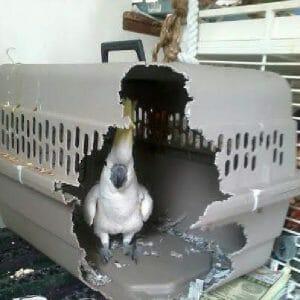Last Updated on by Mitch Rezman
A couple of months ago we talked about the how to’s of traveling with your bird. the physical portion of terrestrial travel doesn’t change whether you’re traveling in town or across the country.
You can travel with your bird by air or by car. We talked about Disaster preparation with your bird. Here’s a great page that outlines what you need to do and lists a whole bunch of pet friendly hotels and motels which dovetails with our talk about travel today.
Crossing state lines changes the game and the last thing you want to do is to lose your bird to a state agency for lack of preparation. Do a quick check on the laws of every state you will be in
It’s best to have a veterinarian-supplied current (within 10 days to 2 weeks) health certificate while on the road. Also make sure that the state you are in or traveling through has not issued any bird quarantines.
Microchips are best for identification or at the very least you should have birth records on hand. A few pictures of your bird and you and family members, etc could be handy but don’t count on pictures alone..
There are several states that ban Quaker parrots. Some of the states are California, Georgia, Kansas, Kentucky, Hawaii, New Jersey, Pennsylvania, Tennessee, and Wyoming. If you live in New York or Virginia you have to register your Quaker with the state and if you live in Connecticut and you have a Quaker, you can’t sell it or breed it, –
As for air travel, I’m told Delta is the best by some of our customers. They are supposed to really bend over backward to accommodate pets and they have a very comprehensive webpage found here:. American Airlines does a nice job as well explaining their in-flight pet policies.
The international bird carrier caper
We recently had a customer come into the shop who was retiring to Ecuador and mirthfully she was bringing her Macaw back to the real home of Macaws. She had brought in a large dog crate she wanted to add some very deep bowls to and a Manzanita perch for the bird to travel on. Back in June, we talked about “best practices” the how to’s of traveling with your bird. Air travel places added on your bird with high-velocity inertia and lots of scary noises and darkness.
Interestingly I learned Delta was requiring her to cover any and all holes in the carrier with a metal mesh from the inside of the carrier so the bird could not poke its beak out of any of the holes. She was on her way to a home improvement store after us to complete the international bird carrier project caper.
She knew she wanted deep bowls because of the ten-hour flight but – if any of you cage manufacturers are reading this apparently there are no deep bolt on dishes. So after much analysis, it was decided that once again necessity would be the mother of invention. Prevue does make a very nice stainless steel deep dish for big birds. They are very popular replacements or as additional “clean” dishes to hasten daily feeding of said birds.
Then Mitchguyver sprung into action. I grabbed a couple of spare Prevue cage feeder cup rings from my toolbox, pulled a handful of cable ties from the quiver I wear on my back filled with them all the time, and the Ryobi Cordless drill.
Engineering on the fly is always a fun challenge and the end product resulted in that rush of serving a very happy customer and hopefully a slightly somewhat comforted bird during a long flight to South America ironically never flapping its wings to get there.
The paperwork avalanche
She said she’d been working on the documentation for about six months and was weeks away from the final trip. This is because if you want to travel outside of the country expect your next part-time job to be job security for bureaucrats. Most of the birds that we all care for except for budgies and cockatiels are species listed under CITES (Convention on International Trade in Endangered Species of Wild Fauna and Flora) Expect to obtain things like an import, export, or re-export of personal pets listed under CITES – permit. A pet passport as well as the normal veterinary and proof of ownership documentation. Remember all birds of a given species look-alike A picture alone ain’t gonna cut it. Here’s a really good page on foreign travel with your bird.
It’s also recommended that you:
-
Contact the visiting country’s consulate or embassy for information about any requirements that you must meet. A listing of consulates can be found on the U.S. Department of State website.
So the next time you daydream about that winning lottery ticket burning a hole in your wallet and all the world travel you are going to do with your favorite feathered friend, remember – the devil’s in the details.
Written by Mitch Rezman
Approved by Catherine Tobsing
Author Profile
Latest entries
 The Traveling BirdJune 26, 2025Can You Name 5 Parrot Species That Are Living Wild in the USA?
The Traveling BirdJune 26, 2025Can You Name 5 Parrot Species That Are Living Wild in the USA? Bird BehaviorJune 26, 2025How is it Parrots Are Problem Solvers Social Animals and Even Use Tools?
Bird BehaviorJune 26, 2025How is it Parrots Are Problem Solvers Social Animals and Even Use Tools? Bird & Parrot AnatomyJune 25, 2025How a Tiny Chemical Modification Makes Parrots Nature’s Living Paintings
Bird & Parrot AnatomyJune 25, 2025How a Tiny Chemical Modification Makes Parrots Nature’s Living Paintings PigeonsJune 20, 2025How Do Parrots Thrive in Cities Outside Their Native Habitats?
PigeonsJune 20, 2025How Do Parrots Thrive in Cities Outside Their Native Habitats?




